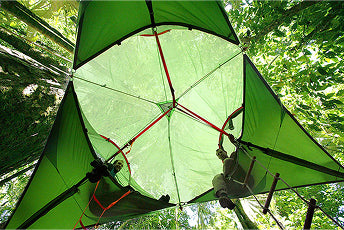After a season of adventures into the great outdoors, it’s not always fun to think about cleaning your gear. We’ve put together this simple guide to help keep your Tentsile fresh and clean, ready for many years’ outings!

photo credit: Tommy Ferlatte
1. First, check and prep your Tentsile. Some of the great outdoors may have followed you home, so make sure it’s all gone before your next trip! Watch out for sharp twigs or stones, and, while tree sap can be messy, it won’t damage your Tentsile. Products like Scrubba by Teufelberger are specifically designed to clean load bearing textiles, good to wipe off sap along with the next step…
2. Clean with gentle products. With warm water, non-detergent soap and a non-abrasive sponge, gently scrub dirty patches. Many household soaps may contain bleach or perfumes. These scents can attract creepy crawlies, critters, or bigger animals! Avoiding bleach, stain remover and dishwashing liquids will also help protect the durable water repellent coating on your Tentsile’s floor and rainfly. Thoroughly rinse away soap with water, if you notice any uncertain smells when camping it may be left over cleaning product in the fabric.
**Never machine wash or dry a tent! These machines can stretch, tear and cause heat damage to the fabric, insect mesh and seams.
3. Inspect and treat your rainfly. While cleaning, keep a close eye on your rainfly. Keeping this in good condition can be the difference between a cosy night in nature and a soggy sleep outside! Water-proofing sprays used for most tents can be applied to your Tentsile; just make sure to read the individual instructions.
4. A simple scrub to keep straps clean. While straps may be more durable than the fabric and rainfly, treating them with a little TLC will help to prolong their lifespan. Again, a gentle detergent must be used with warm water. Grab your soft sponge and start wiping away dirt and debris. While all of our straps use polyester to limit water absorption, they still need to be hung out to dry fully before packing away.
5. Keep your ratchets in good, clean condition. Wipe away dirt with a damp cloth to maintain the ratchet in full working order. Maintenance oils can be applied to moving parts, but avoid using vegetable and cooking oils. Products like ‘Duck Oil’ by Swarfega lubricates and protects the ratchet without attracting dirt and residue.
6. Thoroughly air-dry your Tentsile. This is important after every outing and cleaning. For the Tentsile Tree Tent this could mean full set up for a few hours, or simply insert the poles with the inner tent flat on clean ground. Otherwise, hang it in a shady spot until completely dry and airy - Make sure it’s not in direct sunlight, as water can add to the effects of UV rays.
Only when completely dry can you then pack it up and store…
7. Store the Tentsile bag flat in a cool, dry place. For the fabric and rainfly, warm and damp storage spots (like an attic or basement) will only help mould and mildew to spread. If you can’t find a cool, dry alternative, placing the Tentsile bag in a sealed container will do the job. Additionally, for the particularly vigilant, storing tent bags flat, instead of an upright position, can prevent damage to poles.











